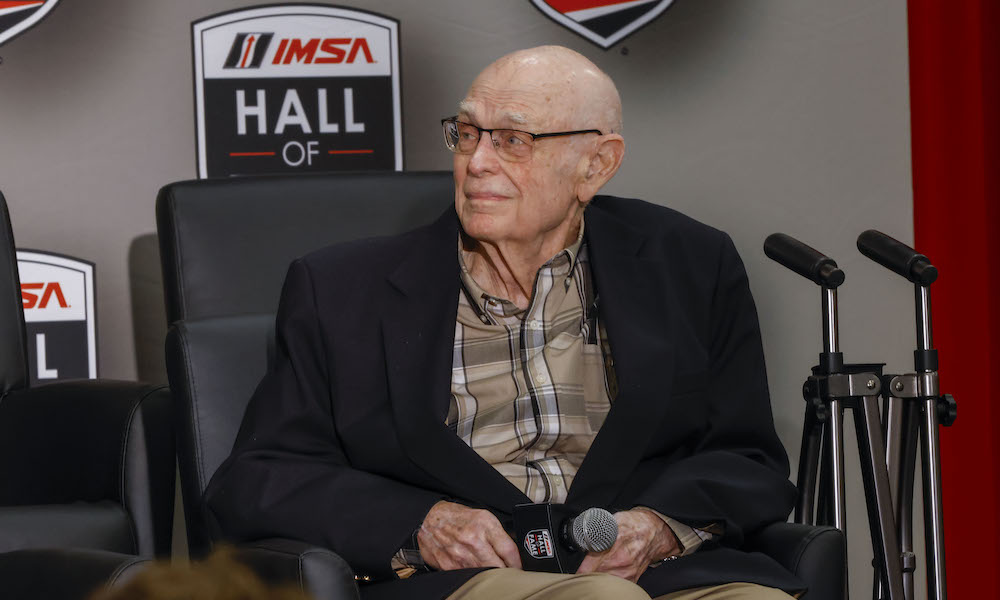Bob Riley, who left an indelible mark on IndyCar and sports car racing through cars such as Coyote Indy cars for A.J. Foyt, front-engine Mustang GTPs, the high-downforce Intrepid RM-1, the dominating Riley & Scott Trans Am cars and Mk III prototype, and the Riley Daytona Prototype chassis, has passed away at the age of 93.
A 2024 inductee into the IMSA Hall of Fame as well as a member of the Motorsports Hall of Fame of America, Riley’s career as an engineer and car designer stretched across multiple racing disciplines. A mechanical and aeronautical engineer, he worked in the aircraft industry and Chrysler’s Space Division Saturn rocket program, while building race cars at home, notably the legendary Lynx Formula Vee. Building race cars would soon become his calling.

As an engineer for Ford, Riley contributed to the Le Mans-winning Ford GT MK IV program. A few years later, he was designing Coyote Indy car chassis for A.J. Foyt, including the car which carried Foyt to his fourth Indianapolis 500 win. The 1981 Coyote, Riley’s first full ground-effects Indy car, produced so much downforce the team couldn’t find springs strong enough, and had to cut holes to bleed off some of the pressure.
Riley’s first solo effort in sports car racing was the front-engine Ford Mustang GTP, an unusual design in 1983. (See below video). Making its debut late in the season at Road America for Zakspeed, the car was an immediate success with a 1.7-liter Ford Cosworth BDA engine, carrying Klaus Ludwig and Tim Coconis to victory, while Bobby Rahal and Geoff Brabham finished third. The car’s subsequent outings mostly resulted in failure, however, due to the fragility of the 2.1-liter engine that went into the car for the 1984 IMSA GT season.
Riley’s next GTP car was the Intrepid RM-1, designed with son Bill and produced by Pratt & Miller. The car was notable for its exceptionally high levels of downforce, which gave it the fastest cornering speeds of any of the GTP cars of the era. Powered by a Chevrolet engine, Wayne Taylor won with the car on the streets of New Orleans during its 1991 debut season, the chassis’ only victory.
In 1990 Riley teamed up with Mark Scott to form Riley & Scott. The first car the company developed was the Mk I Trans Am chassis that scored numerous victories in the series, and also found success in IMSA competition. But it was the Mk III World Sports Car chassis that made the company’s name and dominated the WSC category in the late ’90s, regularly besting even the mighty Ferrari 333SP. Wayne Taylor and Doyle Racing took the first championship with an Oldsmobile-powered Mk III, followed by four straight championships for Dyson Racing with Ford power, Butch Leitzinger with two, followed by a pair for James Weaver.
The Mk III took three of four Daytona 24 Hours overall victories from 1996-99, one with Doyle and two for Dyson. The chassis would take nearly 50 victories, and also became the basis for the Cadillac Northstar LMP, and the updated Mk III C that raced until 2005.
Riley & Scott also built an Indy Racing League chassis, the Mk V that scored a victory with Buddy Lazier at Phoenix, before the company was acquired by Reynard in 1999.
The current company created by Bob and Bill Riley in 2001, Riley Technologies, built the Riley Mk XI. That car and its successors won the Daytona 24 Hours 10 times from 2005-15 in the hands of Wayne Taylor Racing, Chip Ganassi Racing, Brumos, Action Express and Michael Shank Racing. Those victories came with different powerplants, including Pontiac, Lexus, Porsche, BMW and Ford.
Other notable sports car racing projects for Riley include developing the SpeedSource RX-7s and the Viper GTS-R that ran in ALMS and IMSA GTLM competition from 2012-14, as well the Viper GT3-R.
“It’s hard to condense his career into something short and sweet,” noted IMSA Senior Director of Competition Mark Raffauf on the occasion of Bob Riley’s induction into the IMSA Hall of Fame. “He probably was directly involved or personally conceived at least 20 significant [designs].
“In my opinion, he is the single most significant American race car designer in history. I could dig up a list of what he made in IMSA and it’s just mind-boggling.”
Riley Motorsports continues to compete under the direction of Bill Riley in the IMSA WeatherTech SportsCar Championship in LMP2 and in GT World Challenge America. Chris Dyson is racing with Riley Technologies chassis in Trans Am, and the company has taken over Kar-Kraft and is building a MkIv continuation.
“Dyson Racing’s association with Bob Riley goes back to 1994, when he consulted on the development of the team’s Spice-Ferrari WSC car,” said Rob Dyson. “With our encouragement Bob designed and his company Riley & Scott developed the Mk III chassis for the IMSA World Sports Car Championship,” Rob Dyson said. “Bob was one of the cornerstones in the foundation of Dyson Racing’s long-term success. Beginning in 1995 the Riley & Scott Mk III brought eight years of success, including four consecutive series championships and victory in the Rolex 24 at Daytona in 1997 and 1999.”
Chris Dyson, the three-time and defending Trans Am champion who currently campaigns a Riley Ford Mustang, said, “Twenty-four years ago I began my professional racing career in a Riley & Scott Mk III. And this year I’m still winning races in a car that Bob designed. That Bob remained a thoughtful and creative force in race car design through his 80s and into his early 90s is a testament to how his work continues to influence the sport. It was my honor to work with him and enjoy so much success together.”
